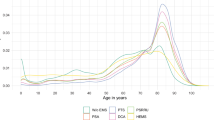Abstract
Objective
This study describes the development of a Discrete Event Simulation (DES) of a large pediatric perioperative department, and its use to compare the effectiveness of increasing the number of post-surgical inpatient beds vs. implementing a new discharge strategy on the proportion of patients admitted to the surgical unit to recover.
Materials and methods
A DES of the system was developed and simulated data were compared with 1 year of inpatient data to establish baseline validity. Ten years of simulated data generated by the baseline simulation (control) was compared to 10 years of simulated data generated by the simulation for the experimental scenarios. Outcome and validation measures include percentage of patients recovering in post-surgical beds vs. “off floor” in medical beds, and daily census of inpatient volumes.
Results
The proportion of patients admitted to the surgical inpatient unit rose from 79.0 % (95 % CI, 77.9–80.1 %) to 89.4 % (95 % CI, 88.7–90.0 %) in the discharge strategy scenario, and to 94.2 % (95 % CI, 93.5–95.0 %) in the additional bed scenario. The daily mean number of patients admitted to medical beds fell from 9.3 ± 5.9 (mean ± SD) to 4.9 ± 4.5 in the discharge scenario, and to 2.4 ± 3.2 in the additional bed scenario.
Discussion
Every hospital is tasked with placing the right patient in the right bed at the right time. Appropriately validated DES models can provide important insight into system dynamics. No significant variation was found between the baseline simulation and real-world data. This allows us to draw conclusions about the ramifications of changes to system capacity or discharge policy, thus meeting desired system performance measures.


Similar content being viewed by others
References
Coats TJ, Michalis S (2001) Mathematical modelling of patients flow through an accident and emergency department. Emerg Med J 18(3):190–192
Connelly LG, Bair AE (2004) Discrete event simulation of emergency department activity: a platform for system-level operations research. Acad Emerg Med 11(11):1177–1185
Hung GR, Whitehouse SR, O’Neill C et al (2007) Computer modeling of patient flow in a pediatric emergency department using discrete event simulation. Pediatr Emerg Care 23(1):5–10
Marmor YN, Rohleder TR, Cook DJ et al (2013) Recovery bed planning in cardiovascular surgery: a simulation case study. Health Care Manag Sci. doi:10.1007/s10729-013-9231-5
Zhu Z, Hen BH, Teow KL (2012) Estimating ICU bed capacity using discrete event simulation. Int J Health Care Qual Assur 25(2):134–144
Troy PM, Rosenberg L (2009) Using simulation to determine the need for ICU beds for surgery patients Surgery. Surgery 146(4):608–620
Stahl JE, Furie KL, Gleason S et al (2003) Stroke: effect of implementing an evaluation and treatment protocol compliant with NINDS recommendations. Radiology 228(3):659–668
Monks T, Pitt M, Stein K et al (2012) Maximizing the population benefit from thrombolysis in acute ischemic stroke: a modeling study of in-hospital delays. Stroke 43(10):2706–2711
Barrett J, Skolnik J, Jayaraman B et al (2008) Discrete event simulation applied to pediatric phase I oncology designs. Clin Pharmacol Ther 84(6):729–733
Day TE, Al Roubaie AR, Goldlust EJ (2013) Decreased length of stay after addition of healthcare provider in emergency department triage: a comparison between computer-simulated and real-world intervention. Emerg Med J 30(2):134–138
Karnon J, Stahl J, Brennan A et al (2012) Modeling using discrete event simulation: a report of the ISPOR-SMDM modeling good research practices task force-4. Med Decis Mak 32(5):701–711
Tyler DC, Pasquariello CA, Chen C-H (2003) Determining optimum operating room utilization. Anesth Analg 96:1114–1121
Ragavan MV, Blinman TA, Fieldston ES (2013) Scheduled surgery admissions and occupancy at a children’s hospital: variation we can control to improve efficiency and value in health care delivery. Ann Surg 257:564–570
Fieldston ES, Ragavan M, Jayaraman B et al (2011) Scheduled admissions and high occupancy at a children’s hospital. J Hosp Med 6(2):81–87
Eldabi T, Irani Z, Paul RJ (2002) A proposed approach for modelling health-care systems for understanding. J Manag Med 16(2/3):170–187
Rutberg M, Wenczel SL, Devaney J, Goldlust EJ, Day TE (2013) Incorporating discrete event simulation into quality improvement efforts in health care systems. Am J Med Qual. doi:10.1177/1062860613512863
Acknowledgments
The authors appreciate the efforts of Lori Crowder, MHA BSN RN CNOR, Dylan Horn, MBA, Judith E. Kraft, MBA, Sonia Joiner-Jones, RN, and Michael L. Nance, MD in providing insight into the perioperative process and assisting with face validation for this investigation. In addition, the authors thank Melissa Bates, PhD, for manuscript review.
Conflict of interest
The authors received no external support for this study.
Author information
Authors and Affiliations
Corresponding author
Rights and permissions
About this article
Cite this article
Day, T.E., Chi, A., Rutberg, M.H. et al. Addressing the variation of post-surgical inpatient census with computer simulation. Pediatr Surg Int 30, 449–456 (2014). https://doi.org/10.1007/s00383-014-3475-0
Accepted:
Published:
Issue Date:
DOI: https://doi.org/10.1007/s00383-014-3475-0




